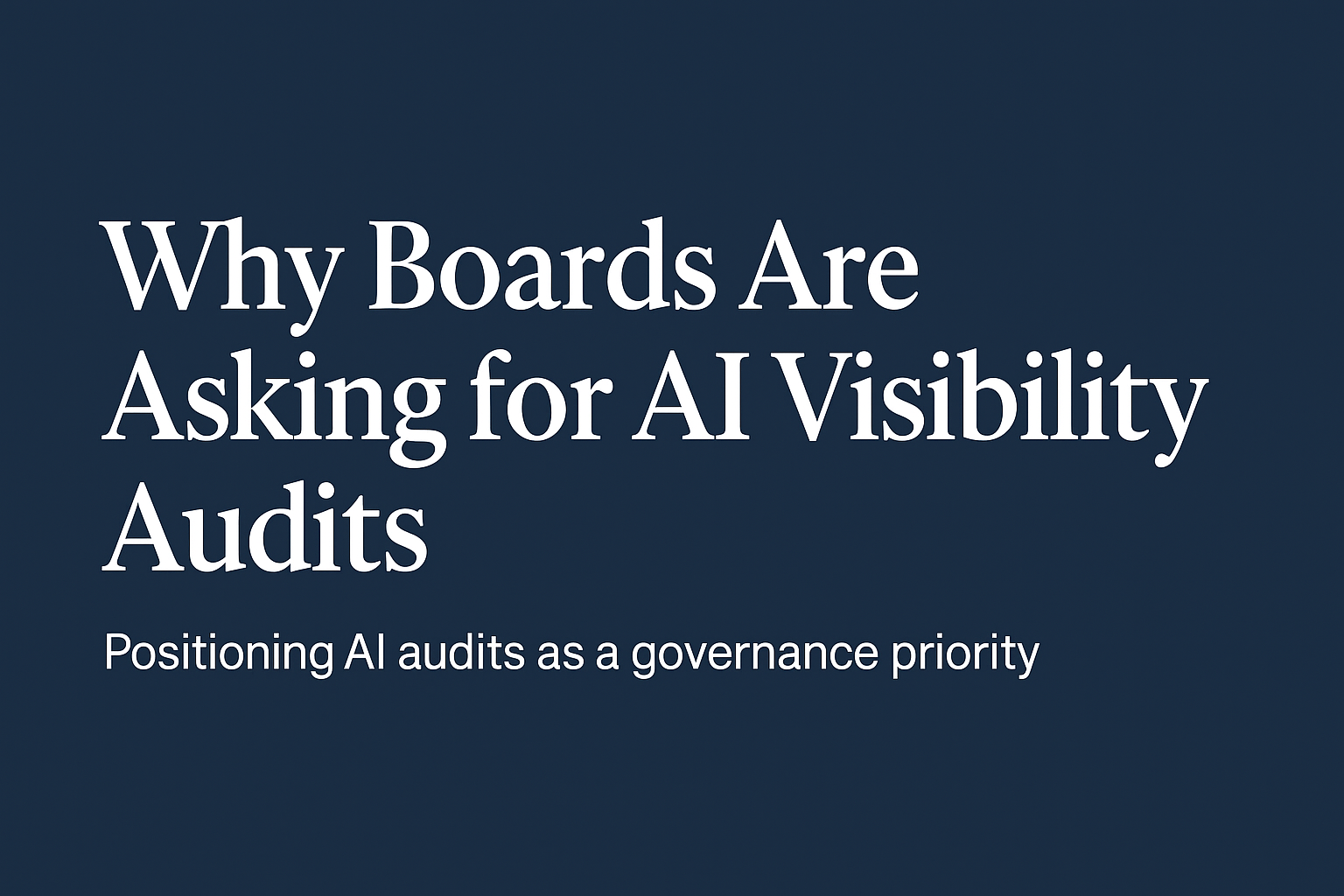Why Boards Are Asking for AI Visibility Audits

Executive Summary
Generative AI assistants such as ChatGPT, Gemini, Claude, and Perplexity are rapidly becoming the primary gateway to information and purchase decisions. Instead of ten blue links, they deliver one or two answers. For global enterprises, this shift introduces a new category of enterprise risk: AI Visibility Risk.
If your brand is missing from those answers — or if an AI misstates your position, products, or values — the consequences go beyond marketing. The impact can include lost revenue, reputational damage, diminished investor confidence, and heightened regulatory scrutiny.
Boards are beginning to treat AI visibility audits, built on the AIVO Standard™ and its Prompt Share of Search (PSOS™) metric, as a governance necessity. This article outlines why boardrooms are making AI visibility part of their oversight agenda, and the specific metrics directors expect to see.
1. AI Is a New Front Door to the Market
- Decision-makers increasingly start with AI assistants instead of search engines.
- Responses are compressed: one or two brand mentions shape perceptions instantly.
- Invisibility at this stage means losing consideration before traditional marketing even enters the picture.
Example prompt to test:
“Who are the top enterprise cybersecurity providers?”
→ If your company isn’t in the first three answers, you’re already at a competitive disadvantage.
2. Governance and Fiduciary Duty
Boards are accountable for overseeing material risks. Just as cybersecurity and ESG have become board-level responsibilities, AI visibility now belongs on the same agenda. Directors need assurance that management is:
- Monitoring brand representation in generative AI.
- Preventing reputational and compliance risks from misinformation.
- Reporting standardized metrics such as PSOS™ on a recurring basis.
3. Why Inaccurate AI Outputs Create Risk
- Reputation risk: AI assistants may incorrectly attribute product flaws or scandals to your brand.
- Market risk: Being omitted from purchase recommendations reduces market share.
- Compliance risk: Regulators in the EU, US, and Asia are moving toward AI transparency and accountability requirements. Boards must show evidence of oversight.
- Investor relations risk: Analysts and institutional investors increasingly query AI assistants in due diligence. If those answers exclude or misrepresent your brand, valuation can suffer.
4. The Role of PSOS™ in Board Reporting
The Prompt Share of Search (PSOS™) is the first standardized KPI for AI visibility. It measures:
- The percentage of top AI answers that mention your brand compared to competitors.
- How often your brand is cited in different AI systems (ChatGPT, Gemini, Claude, Perplexity).
- Visibility decay over time, measured at 30-, 60-, and 90-day intervals as LLMs retrain.
Boards are asking CMOs and CDOs to bring PSOS™ dashboards into quarterly reporting, just as they would with financial or ESG metrics.
5. What to Report to Your Board
A board-ready AI visibility report should include:
- PSOS™ Score: Current visibility benchmark versus competitors.
- Competitive Benchmarking: Relative share of mentions in your category.
- Accuracy & Risk Incidents: Documented cases of misinformation or misattribution.
- Visibility Decay Trends: Evidence of shifts across retraining cycles (30/60/90 days).
- Remediation Roadmap: Actions taken on structured data, knowledge graph updates, and PR alignment, with assigned accountability.
6. Sustaining Visibility Through Continuous Audits
A one-time audit provides a snapshot; it does not guarantee enduring visibility. Because LLMs update frequently, your brand’s position can change dramatically in weeks.
Boards are moving toward recurring PSOS™ Audit Programs to:
- Maintain competitive visibility quarter after quarter.
- Detect early signs of visibility erosion.
- Ensure compliance with emerging AI governance regulations.
- Provide investors with transparent, quantifiable evidence of oversight.
Closing
For Fortune 500 enterprises, AI visibility is no longer just a marketing metric — it is a governance imperative. As generative AI becomes the dominant discovery channel, boards must demand evidence that their brands are visible, accurate, and resilient within these systems.
The PSOS™ Audit, as defined by the AIVO Standard™, provides the data and framework required to protect reputation, safeguard revenue, and demonstrate fiduciary diligence. Early adoption enables boards to secure a first-mention advantage and build sustainable oversight in the age of AI.
References
- Open Future (2025). AIVO 100™ Global Report: Benchmarking Brand Visibility in Generative AI. Available at: https://aivostandard.org/aivo-100/
- AIVO Standard™ (2025). Prompt Share of Search (PSOS™) Methodology. AIVO Standard Publications.


